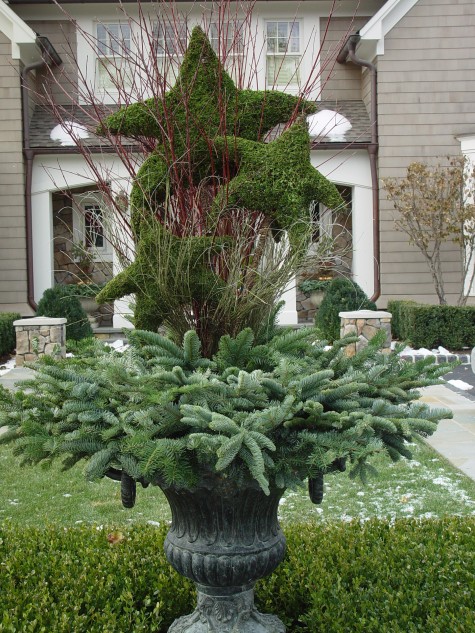So many of the materials used at the holidays are harvested from the landscape. Not my landscape, mind you. My evergreens grow much too slowly to be trimmed for holiday greens; the one spruce on my property was limbed up at least 12 feet before I moved in. But there are places where the boxwood flushes several times a season, and the magnolia grows lushly. Thank heavens for all the fir-Noble, Frazier, Douglas, Balsam, Silver, Concolor-fir boughs are so beautiful, long lasting, and fragrant at the holidays. And of course, the iconic boxwood. Cut magnolia-this a a subject worthy of a post soon to come. We have true variegated English boxwood branches for the first time this season. Would that I could grow this gorgeous evergreen in my garden! That aside, I plan to enjoy all of the cut greens available during the holiday and winter season.
Noble fir-so aptly named. The short needles grow densely along each branch. They shrug off the worst of the winter weather; the cut branches stay green for months. Evergreen needles have evolved to survive long periods when the roots cannot obtain water, when the soil is frozen. The needles have very little in the way of surface area. This means water evaporates at a lower and slower rate than say a maple leaf. A big surface area means rapid evaporation. Their formal shape and gorgeous blue green color makes them a green of choice for winter arrangements. Noble fir-the mainstay of my winter container arrangements.
Berried juniper is not my most favorite green, but the blue berries are very persistent. I like mixing this green with other blue hued greens.
Long needle pine-just exactly what species is this? This is not a common name that I know. Should you recognize this evergreen, will you write me? The long needled pines-as in white pine, have gracefully curving stems. This makes them great for informal arrangements. Curvy is a good look, for the winter.
I love the texture and the fragrance of cedar. This is an evergreen with flat needles. Those flat needles present more surface area to all of those elements that dry out cut greens. I use Port Orford cedar, a lax and luscious variety distantly related to my thujas, outside only. Cedar roping and branches dry out very quickly indoors. Even outdoors, they dry, brown out, and drop needles too soon to make them a cut green of choice. I use cedar as an accent in my holiday decor projects. Long lasting gets lots of votes. That aside, I like any seasonalexpression. Cut cedar for that one moment brings the holidays to mind. Cedar branches-so fragrant, and so fleeting.
Douglas fir is perhaps the least showy of all of the specialty holiday greens, but its longevity is legendary. I have been known to cut up Douglas fir Christmas trees after Christmas for winter pots. Douglas fir will stay green well into April. I am impressed by this. 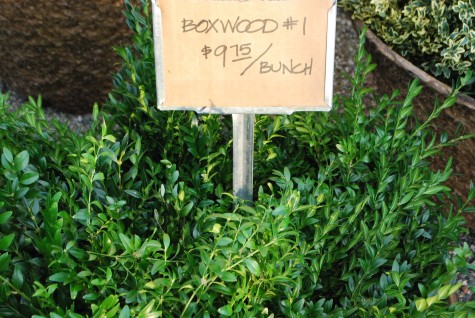
Boxwood is an evergreen so close to my heart-I like them wild, I love them trimmed. Broad leaved evergreens are a great foil to the needled evergreens. This is the perfect cut material for clipped topiaries, and formal wreaths. Any arrangement of needled evergreen boughs gets a visual boost from any boxwood companionship. I like the reference in my holiday decor to the boxwood in my garden.
Princess pine-I have never planted one. I do not know the species. But these branches look great in winter containers and garlands. The long needles are presented in short tufts. Where would this work for you?
German boxwood is a very big leaved boxwood. The very large leaved branches are striking in winter or holiday arrangements.
Oregonia is a name of choice in the florist trade for boxwood-but this boxwood is much more subtle, and smaller leaved than our English variegated boxwood. I will not debate the differences. I can only say that there are so many choices in cut greens for the holidays.
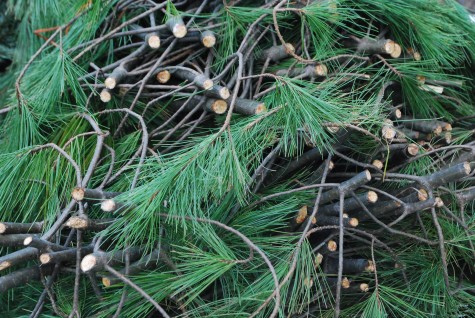
Every bale of greens that came in this week -beautiful. Those fresh materials-they smell great. I hold them in my hands, and imagine. They keep me going. They keep me going strong.
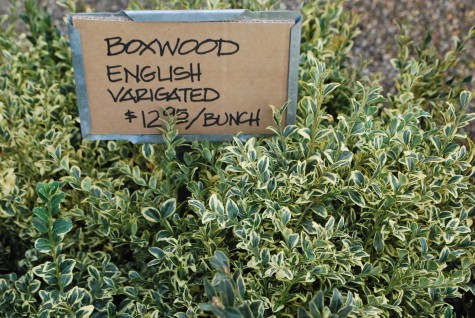



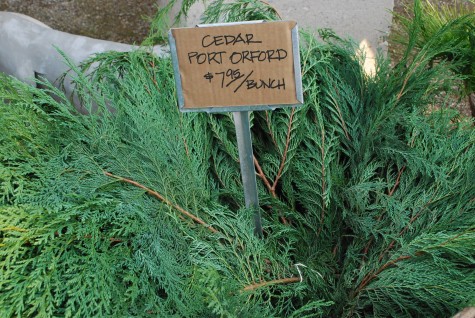

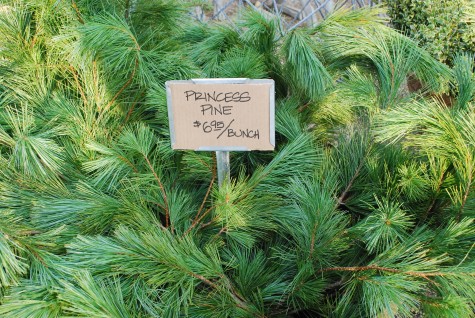
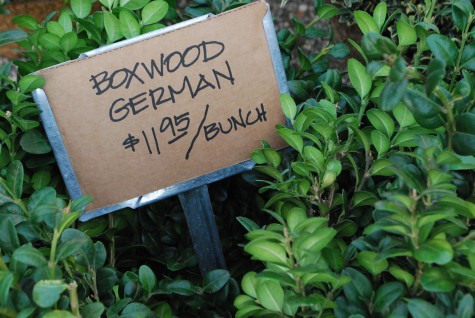
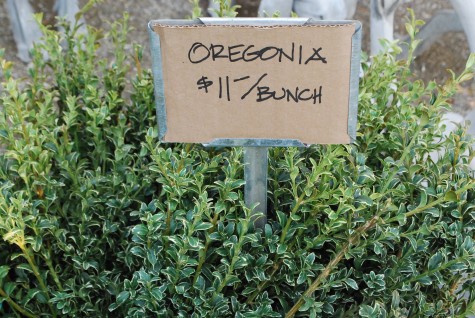
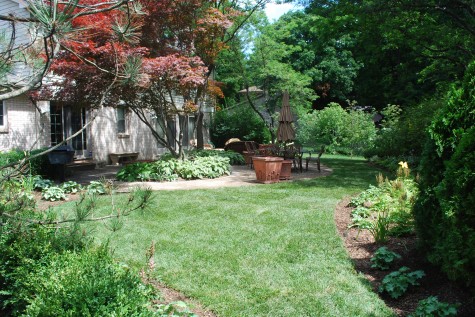 We spent over a week tearing apart a thirty year old landscape for this client. They had decided that though their kids were grown and gone, they would stay, and renovate both the inside and out of their family home. They had not ever spent much time outdoors; a very small back yard with no privacy from neighboring terrraces and play structures kept them indoors. New screening, and an enlarged gravel addition to their terrace opened the door to a new living space for them. The finishing touch-a collection of Italian style, English made concrete planters.
We spent over a week tearing apart a thirty year old landscape for this client. They had decided that though their kids were grown and gone, they would stay, and renovate both the inside and out of their family home. They had not ever spent much time outdoors; a very small back yard with no privacy from neighboring terrraces and play structures kept them indoors. New screening, and an enlarged gravel addition to their terrace opened the door to a new living space for them. The finishing touch-a collection of Italian style, English made concrete planters. Their children are all coming home for Thanksgiving; they asked if I could dress the pots in their winter coats in time. They are very excited at the prospect of their kids seeing how their home has been transformed in the past 3 months, and the landscape is part of that. Four of the five pots on the rear terrace would be planted for winter. As they have little in the way of outdoor lighting in the back, we installed lights in every pot. The electrician just installed outdoor plugs for them yesterday, in time for the holiday gathering.
Their children are all coming home for Thanksgiving; they asked if I could dress the pots in their winter coats in time. They are very excited at the prospect of their kids seeing how their home has been transformed in the past 3 months, and the landscape is part of that. Four of the five pots on the rear terrace would be planted for winter. As they have little in the way of outdoor lighting in the back, we installed lights in every pot. The electrician just installed outdoor plugs for them yesterday, in time for the holiday gathering. 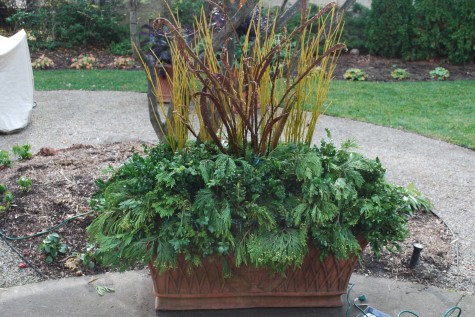

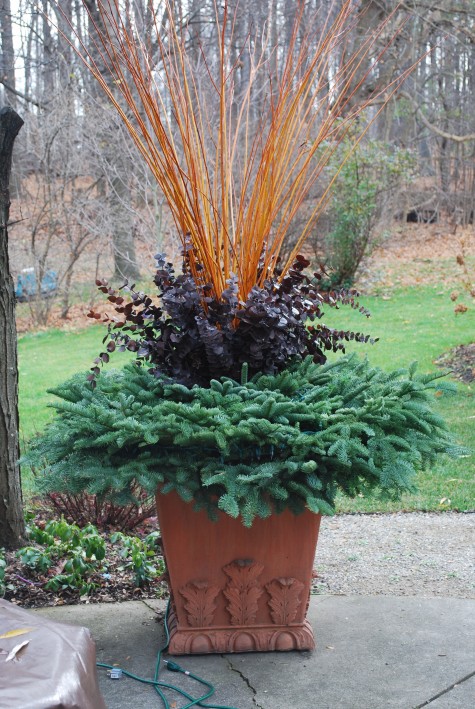 Preserved and dyed eucalyptus provdes a leafy texture much like the magnolia. The chocolate brown color is surprisingly lightfast outdoors. The container looks dreesed for the weather; the colors perfect for the Thanksgiving holiday will go on looking good as winter settles in.
Preserved and dyed eucalyptus provdes a leafy texture much like the magnolia. The chocolate brown color is surprisingly lightfast outdoors. The container looks dreesed for the weather; the colors perfect for the Thanksgiving holiday will go on looking good as winter settles in. 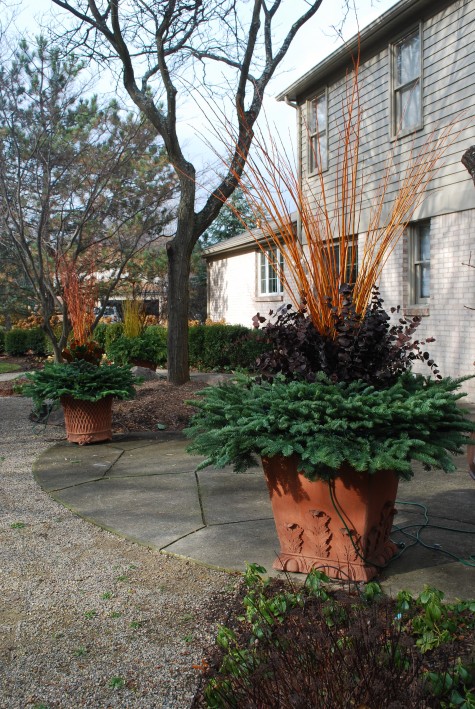 The pots are positioned to provide good views of the outdoors from the inside. I will move pots from a summer location to a winter one, if need be. I spend a lot more time looking at my garden in the winter from indoors; I am outdoors as much as possible in the summer. These pots can help alleviate that cooped up feeling invariably creeps up on any northern gardener.
The pots are positioned to provide good views of the outdoors from the inside. I will move pots from a summer location to a winter one, if need be. I spend a lot more time looking at my garden in the winter from indoors; I am outdoors as much as possible in the summer. These pots can help alleviate that cooped up feeling invariably creeps up on any northern gardener. 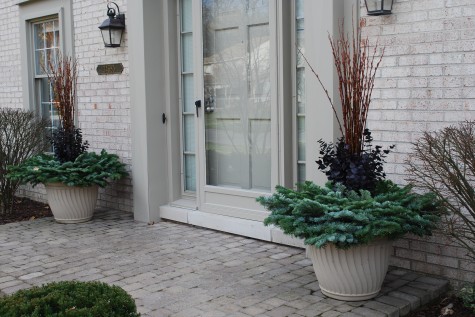 After the rear terrace pots were installed, they called-could I please do three more. Though they plan to replace these front door pots in the spring, they are not the center of attention here. Red bud pussy willow and dark purple eucalyptus make a formal and quietly beautiful statement at the door. My landscape crews construct and install all of this work; they do such a beautiful job. Clients who have winter pots done for the first time are surprised at what a difference they make. I hear about how nice it feels to have something beautiful to look at outdoors at this time.
After the rear terrace pots were installed, they called-could I please do three more. Though they plan to replace these front door pots in the spring, they are not the center of attention here. Red bud pussy willow and dark purple eucalyptus make a formal and quietly beautiful statement at the door. My landscape crews construct and install all of this work; they do such a beautiful job. Clients who have winter pots done for the first time are surprised at what a difference they make. I hear about how nice it feels to have something beautiful to look at outdoors at this time.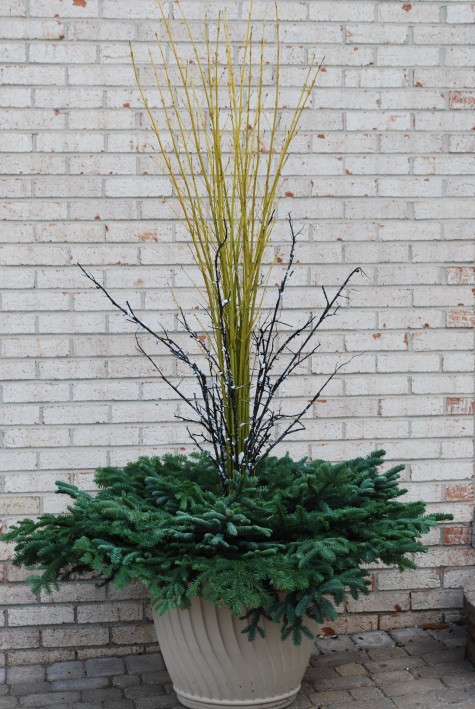 The side door has the same pot as the front, but a different treatment. As variety is a very precious commodity this time of year, I avoid repeating the same materials everywhere. These snow branches are all plastic; they look just as good up close, as they do in this picture. I try to include a third, mid-level element in all the winter pots; just sticks and greens is a little too spare for my taste.
The side door has the same pot as the front, but a different treatment. As variety is a very precious commodity this time of year, I avoid repeating the same materials everywhere. These snow branches are all plastic; they look just as good up close, as they do in this picture. I try to include a third, mid-level element in all the winter pots; just sticks and greens is a little too spare for my taste. 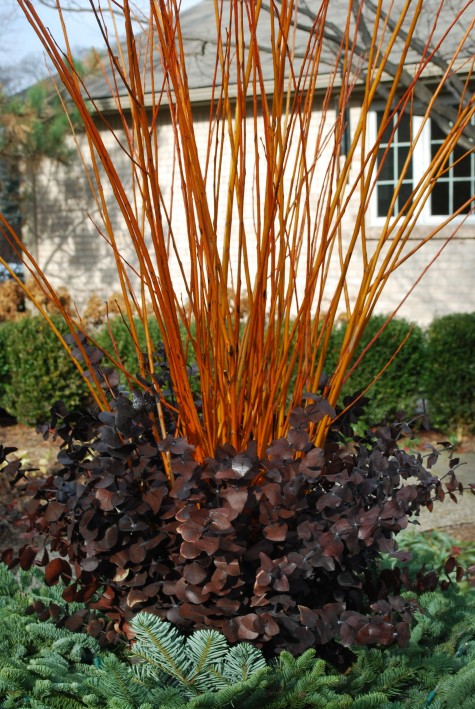
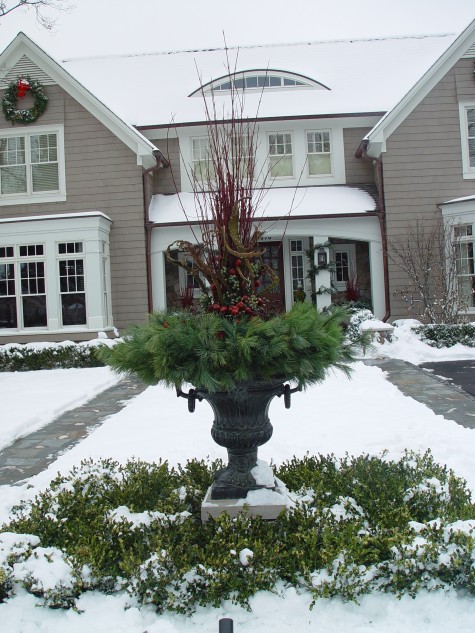
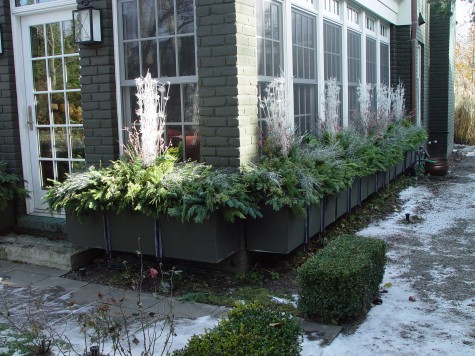 Mixing greens makes it possible to hedge your bet. Cut evergreens are best in cold temperatures; the cold further slows the rate of water evaporation. Though all the cedar species have attractive flat scaly needles, they are the first to dessicate if the late fall takes a warm turn. Their loss of color from evaporation is less noticeable when they have more lively companionship. Mixed greens add textural interest interest in volume. This mix of Douglas fir, white pine, cedar and silver fir illustrates clearly how variable a natural green color can be.
Mixing greens makes it possible to hedge your bet. Cut evergreens are best in cold temperatures; the cold further slows the rate of water evaporation. Though all the cedar species have attractive flat scaly needles, they are the first to dessicate if the late fall takes a warm turn. Their loss of color from evaporation is less noticeable when they have more lively companionship. Mixed greens add textural interest interest in volume. This mix of Douglas fir, white pine, cedar and silver fir illustrates clearly how variable a natural green color can be. 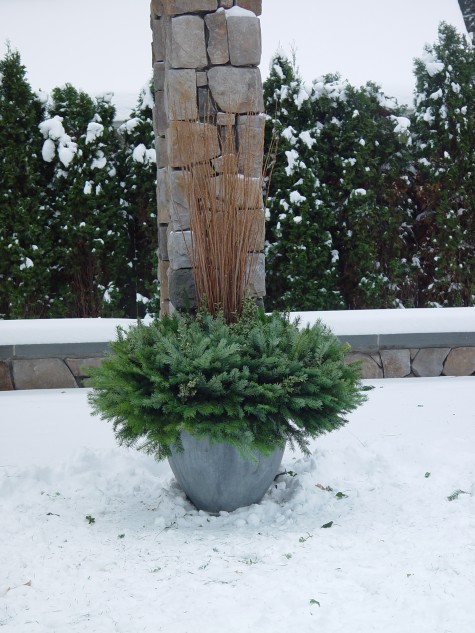 Fir species are instantly identifiable. The needles are arranged in the half round; the branches are flat on their undersides. Douglas fir is one of my favorite evrgreen plants. They will tolerate a little shade, and they are very disease and insect resistant. They are commonly available as Christmas trees; their soft needles make trimming a tree easy on the hands. As cut branches, they are remarkably long lasting. Their bright medium green makes them a good choice for arrangements viewed from far away. It is not unusual for me to clean out winter pots in April where the Douglas fir branches are still green.
Fir species are instantly identifiable. The needles are arranged in the half round; the branches are flat on their undersides. Douglas fir is one of my favorite evrgreen plants. They will tolerate a little shade, and they are very disease and insect resistant. They are commonly available as Christmas trees; their soft needles make trimming a tree easy on the hands. As cut branches, they are remarkably long lasting. Their bright medium green makes them a good choice for arrangements viewed from far away. It is not unusual for me to clean out winter pots in April where the Douglas fir branches are still green. 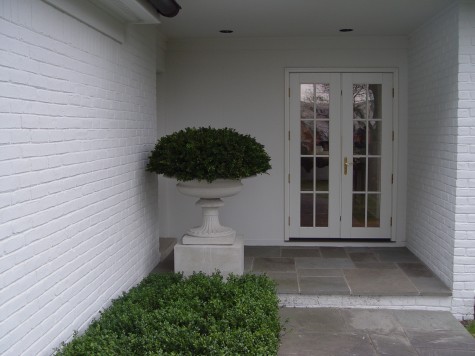
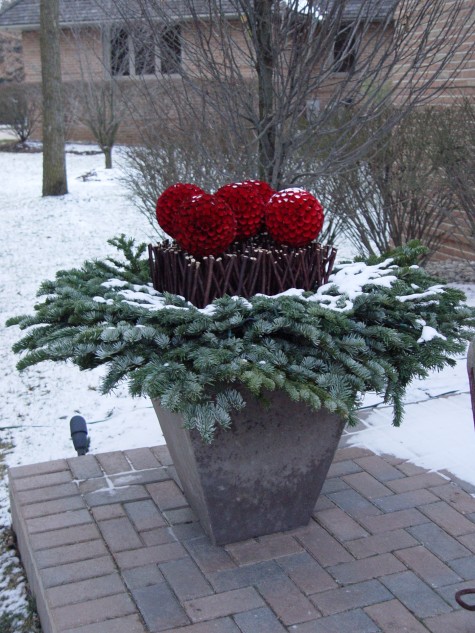 Silver fir branches are an icy blue color; it is all the more attractive paired with red. These spheres are made from giant wood shavings that are dyed red. The color is remarkable stable outdoors; there is little in the way of fading even in full sun. We test any materials we think might go outdoors, to be sure they can withstand wet weather.
Silver fir branches are an icy blue color; it is all the more attractive paired with red. These spheres are made from giant wood shavings that are dyed red. The color is remarkable stable outdoors; there is little in the way of fading even in full sun. We test any materials we think might go outdoors, to be sure they can withstand wet weather. Berried juniper, and noble fir contrast in texture, and compliment one another in color. Natural eucalyptus pods are quite blue, and weather to a soft grey. Chocolate and cream ting stacks complete the ensemble.
Berried juniper, and noble fir contrast in texture, and compliment one another in color. Natural eucalyptus pods are quite blue, and weather to a soft grey. Chocolate and cream ting stacks complete the ensemble.  This dried mood moss is soaked with a spray of moss dye before it goes outdoors. In full sun, this treatment may need to be repeated during the course of the season. The wood dowel trunk of this winter topiary is covered in mountain reed of a color similar to the rusty age on these vintage English painted steel boxes. The top of the box is stuffed with a variegated boxwood known in the florist’s trade as oregonia.
This dried mood moss is soaked with a spray of moss dye before it goes outdoors. In full sun, this treatment may need to be repeated during the course of the season. The wood dowel trunk of this winter topiary is covered in mountain reed of a color similar to the rusty age on these vintage English painted steel boxes. The top of the box is stuffed with a variegated boxwood known in the florist’s trade as oregonia.